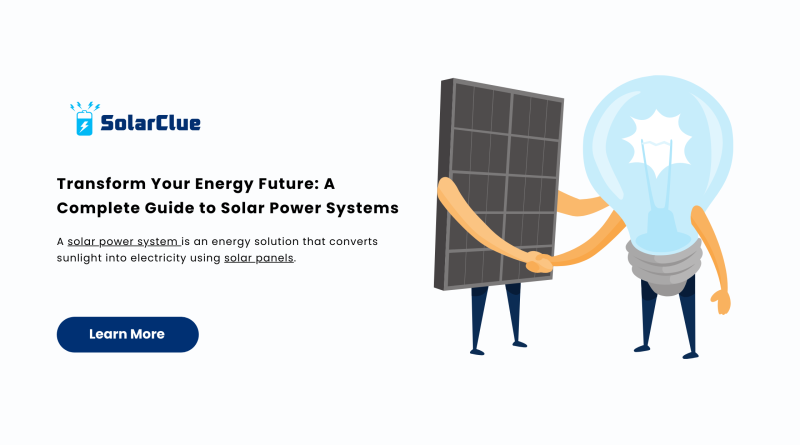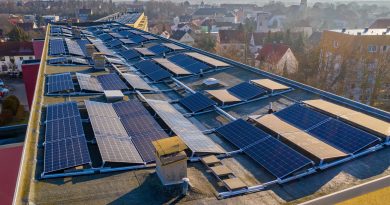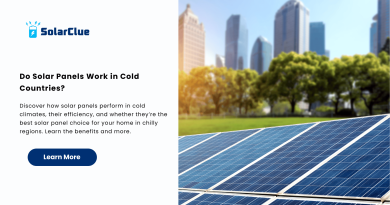Transform Your Energy Future: A Complete Guide to Solar Power Systems
A solar power system is an energy solution that converts sunlight into electricity using solar panels. These systems reduce dependency on fossil fuels and provide a clean, renewable source of power. Installing solar panels for home use is becoming increasingly popular for its long-term benefits.
Table of Contents
- 1 How Does a Solar Power System Work?
- 2 Types of Solar Power Systems
- 3 Benefits of Installing a Solar Power System
- 4 Factors Affecting the Cost of a Solar Power System
- 5 Steps to Install a Solar Power System
- 6 Maintenance and Longevity of Solar Power Systems
- 7 Common Misconceptions About Solar Power Systems
- 8 How to Choose the Best Solar Power System Provider
- 9 Solar Power Systems and Sustainability Goals
- 10 Conclusion
- 11 FAQs
How Does a Solar Power System Work?
A solar power system works through a series of components that collaborate to generate, convert, and distribute energy. Here’s a breakdown of the process:
1. Solar Panels
Solar panels absorb sunlight and convert it into direct current (DC) electricity through photovoltaic (PV) cells. Enhancing solar panel efficiency is essential to maximize energy output.
2. Inverter Conversion
The inverter transforms DC electricity into alternating current (AC), which powers most household appliances.
3. Battery Storage (Optional)
Excess energy can be stored in batteries, allowing for power usage during cloudy days or nighttime. This is an important aspect of off-grid solar energy for home solutions.
4. Electric Grid Connection
Many homes stay connected to the grid to access electricity when solar energy production is low.
Types of Solar Power Systems
Choosing the right system depends on your energy needs and goals. Let’s explore the main types:
1. Grid-Tied Solar Systems
These are connected to the local power grid. Excess power generated is sent back to the grid, often earning credits through net metering.
2. Off-Grid Solar Systems
Independent from the grid, these systems rely entirely on solar panels and battery storage. Ideal for remote locations, they require robust planning to ensure consistent power.
3. Hybrid Solar Systems
Combining the benefits of both grid-tied and off-grid systems, hybrids offer both grid connection and battery backup, providing reliable energy during outages.
Benefits of Installing a Solar Power System
Investing in a solar power system offers numerous advantages, including:
1. Reduced Electricity Bills
By generating your own electricity, you can significantly lower or even eliminate monthly utility bills. The solar power system cost is often offset by long-term savings.
2. Environmental Impact
Solar energy reduces carbon emissions, helping combat climate change and promoting sustainability.
3. Energy Independence
A solar setup reduces dependency on traditional power sources, giving you more control over your energy supply.
4. Increased Property Value
Homes equipped with solar systems for home often have higher market value and attract eco-conscious buyers.
Factors Affecting the Cost of a Solar Power System
The price of a solar power system depends on various factors, such as:
1. System Size
Larger systems generate more power but also come with higher upfront costs. Solar system for home price varies based on energy needs.
2. Type of Solar Panels
Monocrystalline panels offer higher solar panel efficiency but are more expensive than polycrystalline options. Understanding the solar panel price helps in budget planning.
3. Installation Complexity
Roof type, system design, and local labor costs influence installation prices.
4. Incentives and Rebates
Government rebates, tax credits, and net metering programs can significantly offset installation costs for solar panels for home.
Steps to Install a Solar Power System
Installing a solar power system involves a systematic approach to ensure optimal performance:
1. Site Assessment
A professional will evaluate your roof’s orientation, shading, and structural integrity to determine the most efficient solar energy for home design.
2. System Design
Customized designs optimize energy production based on your specific energy needs.
3. Permits and Approvals
Installers handle local permits and approvals before starting the installation.
4. Installation
The process includes mounting solar panels, connecting inverters, and configuring the system.
5. Inspection and Activation
Once installed, the system undergoes inspection before being activated and connected to the grid.
Maintenance and Longevity of Solar Power Systems
A solar power system requires minimal maintenance to remain efficient. Key maintenance tips include:
1. Regular Cleaning
Dust, debris, and bird droppings can reduce panel efficiency. Clean panels periodically for optimal performance.
2. Routine Inspections
Professional inspections help identify and resolve potential issues early.
3. Inverter and Battery Care
Inverters typically last 10-15 years, while batteries may require replacement every 5-10 years.
Common Misconceptions About Solar Power Systems
Despite their growing popularity, several myths surround solar power systems:
1. Solar Panels Don’t Work in Cloudy Weather
While output decreases in low light, solar panels still generate electricity during overcast conditions.
2. Solar Systems Are Too Expensive
Costs have dropped significantly over the years, and incentives make solar more affordable than ever.
3. Maintenance is Complicated
Solar systems are designed for durability and require minimal upkeep.
How to Choose the Best Solar Power System Provider
Selecting a reliable provider ensures a smooth installation and long-term support. Consider these factors:
1. Experience and Reputation
Research reviews, case studies, and testimonials to gauge a provider’s expertise.
2. Warranty and Service Agreements
Comprehensive warranties on solar panels, inverters, and labor offer peace of mind.
3. Customization Options
Choose a provider that offers tailored solutions based on your energy needs and budget.
Solar Power Systems and Sustainability Goals
Adopting a solar power system aligns with global sustainability efforts. It reduces your carbon footprint and contributes to cleaner air, helping meet local and international climate targets.
Conclusion
Investing in a solar power system is a powerful step towards energy independence, cost savings, and environmental stewardship. With various system types and providers to choose from, there’s a solar solution for every household or business.
FAQs
1. How much does a solar power system cost?
The cost varies based on system size, panel type, and installation complexity but typically ranges between $10,000 and $30,000 before incentives.
2. How long do solar panels last?
Most solar panels come with a lifespan of 25-30 years, maintaining efficiency throughout their lifetime.
3. Can I go completely off-grid with solar power?
Yes, but off-grid systems require sufficient battery storage to ensure power availability during low-sunlight periods.
4. What incentives are available for solar power systems?
In many regions, tax credits, rebates, and net metering programs can significantly reduce installation costs.
5. Do solar panels require a lot of maintenance?
No, solar panels require minimal maintenance, with periodic cleaning and routine inspections being sufficient to maintain efficiency.
Discover more on our website! 🌍



